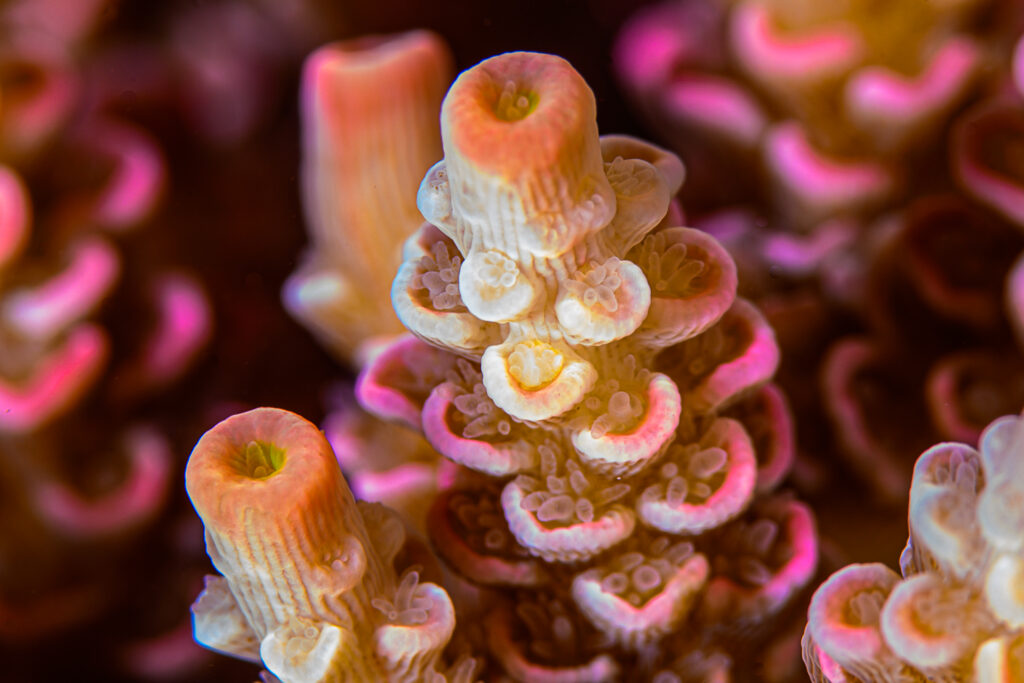
The answer is ‘probably not’! A new publication fresh from the oven just came out last week about the phylogeny of Acropora tenuis.
Tom C.L. Bridge et al. published their research, “A tenuis relationship: traditional taxonomy obscures systematics and biogeography of the ‘Acropora tenuis’ (Scleractinia: Acroporidae) species complex,” in the Zoological Journal of the Linnean Society.

Scientists combined taxonomy with the power of molecular analysis to further understand species complexity within the genus Acropora. It’s highly probable that the genus will undergo massive taxonomic changes in the next few years.


There is just so much new information in this publication, that it’s hard to get a grasp of it in only one post. So let’s just stick to tenuis for the time being.
Acropora tenuis is only from Fiji:
Acropora tenuis is currently known only from Fiji and Tonga in the South Pacific; all other
tenuis-like specimens from other regions are likely to represent distinct species that require additional taxonomic investigation.
2 new species and 5 resurrected:
The publication describes two new species: Acropora rongoi (from the central south East Pacific) and Acropora tenuissima (small branch tenuis from the Great Barrier Reef and Fiji). Then, five additional nominal species are resurrected from synonymy with A. tenuis: A. echinata (original specimen from Fiji, and different from the one on the GBR), A. kenti (from Northeastern Australia, Great Barrier Reef), A. macrostoma (from the Indian Ocean, Mauritius), A. bifaria (from Java, Indonesia), and A. africana (from South Africa).

So if it’s from Fiji, it could be a real tenuis, but if it’s from Indonesia, most likely it should now be called Acropora bifaria, while if it’s from the Great Barrier Reef, Acropora kenti with its very thick branches and lack of tertiary branching and incipient axials is probably the most likely name to apply. Acropora macrostoma and A. bifaria resemble A. kenti in morphology, with neatly arranged cochleariform radial corallites and minimal tertiary branching.
Acropora bifaria:


This species is currently confirmed to occur only in the type locality of Java, Indonesia. This is probably the most abundant species of reef aquarium Acropora, since a lot of Acropora ‘tenuis’ in the aquarium trade originated from Java and Bali. This species has been cultured in the aquarium industry for over 20 years under ‘Acropora tenuis’, and comes in all coloration and shades. But further research is necessary to establish its distribution.
What about Australian ‘tenuis’? A complex evolution pattern:
An interesting point highlighted in this publication is the two ways species of Acropora are created: hybridization or introgression. Both are processes that involve the mixing of genetic material from different populations or species. The key difference between the two is that hybridization produces a single hybrid population with a new generic pattern, whereas introgression leads to the gradual assimilation of genes from one group to another through repeated hybridization and backcrossing.

Evidence of hybridization within some specimens does not indicate that Acropora species represent a syngameon. Instead, it is likely that Acropora, like most other taxonomic groups, can maintain species boundaries despite hybridization in their evolutionary history. In addition, there is increasing evidence that long-distance dispersal in corals is very rare.
The beginning of a massive change in the Acropora taxonomy:

This publication is just the first of many that will follow soon. It is probable that the Acropora family can be divided into six different clades that contain over 400 different species. Acropora tenuis belongs to clade one. Be sure to read the full open-access paper to learn more about the new and resurrected species!
Reference
Tom C.L. Bridge, Peter F. Cowman, Andrea M. Quattrini, Victor E. Bonito,
Frederic Sinniger, Saki Harii, Catherine E.I. Head, Julia Y. Hung, Tuikolongahau Halafihi,
Teina Rongo, Andrew H. Baird, A tenuis relationship: traditional taxonomy obscures systematics and biogeography of the ‘Acropora tenuis’ (Scleractinia: Acroporidae) species complex, Zoological Journal of the Linnean Society, 2023; zlad062, https://doi.org/10.1093/zoolinnean/zlad062




